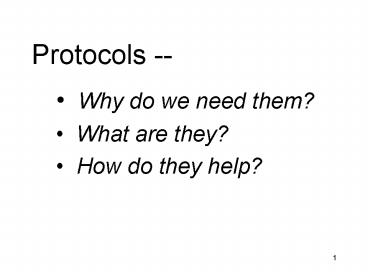Protocols - PowerPoint PPT Presentation
1 / 11
Title:
Protocols
Description:
Force transparency by specifying who does what when. Facilitator, presenter, participant ... [Transparency] helps to create a safe environment for teachers to ... – PowerPoint PPT presentation
Number of Views:21
Avg rating:3.0/5.0
Title: Protocols
1
Protocols --
- Why do we need them?
- What are they?
- How do they help?
2
Group Work
- What are your reactions and concerns when you
hear a facilitator in a professional development
tell you that you are going to get into groups to
work?
3
How do you characterize the typical kind of talk
that occurs in group work?
- Structured?
- Efficient?
- Purposeful?
- Make progress?
- Strategic?
4
3 types of tensions in group work
- Task vs. relationship orientations
- Comfort vs. discomfort
- Autonomy vs. collaboration
5
Protocols help to create trust in collaboration
and group work . . . how?
6
What will build trust?
- Having norms or rules to guide the talk
- Adhering to the steps of the protocol
- Practice! Repeat and use the protocol as needed
over time to guide and structure conversations.
7
What are protocols?
- Structures that enable educators to look
carefully and collaboratively at student and
teacher work in order to learn from it.
8
How will protocols help to improve the quality
and depth of talk?
- Protocols do three things
- Provide a structure for a conversation
- Force transparency by specifying who does what
when - Facilitator, presenter, participant
- Speak, listen, describe, judge
- Transparency helps to create a safe environment
for teachers to put their students work and in
some cases, teachers work, on the table and
listen to others discuss it
9
- No one person or element holds sole
responsibility for the success of a
protocol-guided conversation. In a professional
learning community, we all share responsibility
for the success of a protocol-guided
conversation.
10
- We have learned to use two specific practicesto
develop the capacity of leaders to objectify
their own practiceOne practice involves the use
of protocols to observe, analyze, and develop
practice. We observe instructional practice
using protocols that focus as much as possible on
the visible evidence in the classroom, not on the
personal attributes of the teacher to focus on
the evidentiary claims that people in leadership
positions make to justify their practices, or
their theories of action, rather than the
personal attributes of leaders. The use of
protocols depersonalizes practice and in doing
so, it makes the practice something that can be
changed through learning and further practice.
(Elmore, p. 14)
11
- Why do we want to objectify or depersonalize
practice? - it helps practitioners to objectify their
practice, to put it terms that someone else can
understand and that, if necessary, can be used to
communicate with others and to teach them what
the underlying line of thought and action is. It
also depersonalizes practice so that people can
feel free to treat their own most deeply-held
values and beliefs as empirical propositions that
be subject to verification through evidence on
the effects of what they do - making the invisible visible.
- (Elmore, p. 14)































